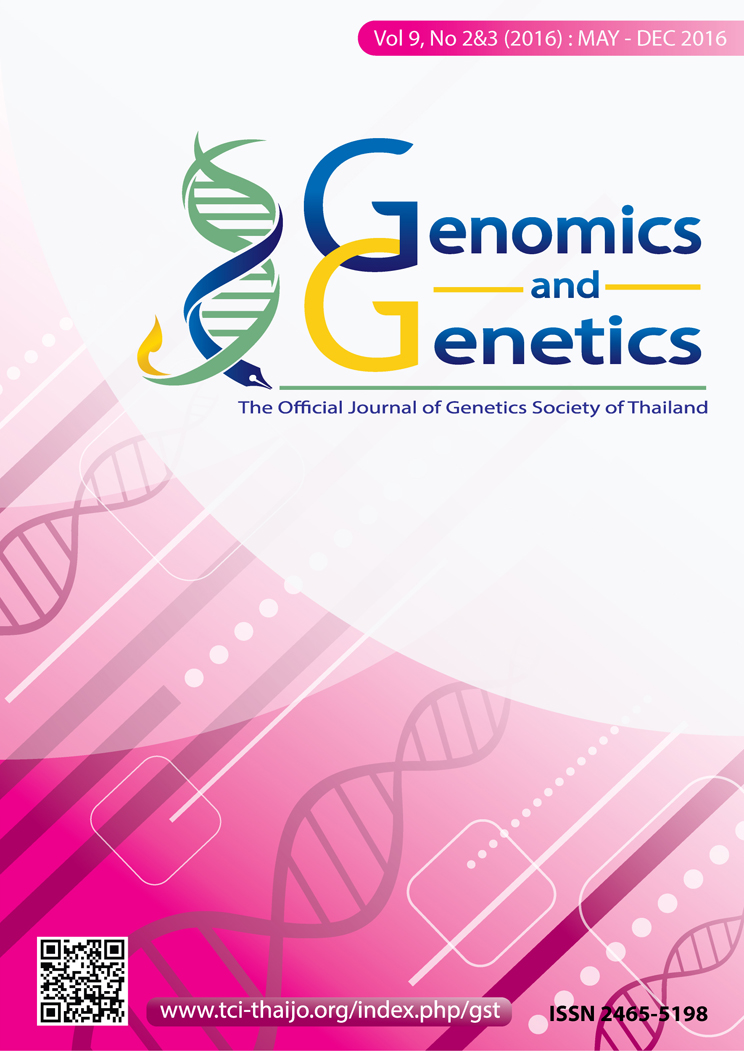Investigation of carrier frequency for spinal muscular atrophy (SMA) in Thailand using dried blood spot (DBS) specimens
Keywords:
spinal muscular atrophy (SMA), dried blood spots (DBS), SMN1-exon 7 deletion, carrier frequency, ThailandAbstract
Spinal muscular atrophy (SMA) is an autosomal recessive genetic disorder, characterized by the degeneration of motor neurons of the spinal cord, thus leading to the deaths of newborns. More than 95% of SMA patients are caused by the absence of survival motor neuron 1 (SMN1) gene exon 7, located on chromosome 5q13. The disease prevalence and carrier frequency of SMA in Thailand have not ever been reported. This research aims to explore the frequency of SMA carriers in whom, SMN1-exon 7 is heterozygously deleted and simultaneously determine the SMN2-exon 7 copy number in Thai population. This may also help to assess the prevalence of SMA in Thailand. We used a denaturing high-performance liquid chromatography (DHPLC)-based semi-quantitative multiplex-PCR technique to detect the copy number of SMN genes by comparing with two reference genes. The analysis was carried out using 1,000 DNA samples extracted from the dried blood spot (DBS) specimens leftover from the Thai National Neonatal Screening Program. Results indicated that the SMA carrier frequency in the Thai newborns is approximately 2.8% (1/36 cases). It can be extrapolated that the prevalence of SMA in Thai newborns caused by homozygous deletion of SMN1 exon 7 is 1 in 5,102 cases. Our findings indicated that SMA can be considered as a national health problem as the incidence found is close to what has been reported elsewhere. The results can also be utilized to establish a national program for clinical, prenatal diagnosis and genetic counseling to effectively prevent SMA in Thailand.
References
Cartegni L, Krainer AR (2002) Disruption of an SF2/ASF-dependent exonic splicing enhancer in SMN2 causes spinal muscular atrophy in the absence of SMN1. Nat Genet 30: 377–384.
Frugier T, Nicole S, Cifuentes-Diaz C and Melki J (2002) The molecular bases of spinal muscular atrophy. Curr Opin Genet Dev 12: 294–298.
Kesari A, Idris MM, Chandak GR Mittal B (2005a) Genotype-phenotype correlation of SMN locus genes in spinal muscular atrophy patients from India. Exp Mol Med 37: 147–154.
Kesari A, Misra UK, Kalita J, Mishra VN, Pradhan S, Patil SJ, Phadke SR, Mittal B (2005b) Study of survival of motor neuron (SMN) and neuron apoptosis inhibitory protein (NAIP) gene deletions in SMA patients. J Neurol 252: 667–671.
Lai AHM, Tan ES, Law HY, Yoon CS, Ng ISL (2005) SMN1 deletions among Singaporean patients with spinal muscular atrophy. Ann Acad Med Singapore 34: 73–77.
Lefebvre S, Bürglen L, Reboullet S, Clermont O, Burlet P, Viollet L, Benichou B, Cruaud C, Millasseau P, Zeviani M, et al. (1995) Identification and characterization of a spinal muscular atrophy-determining gene. Cell 80: 155–165.
Lorson CL, Androphy EJ (2000) An exonic enhancer is required for inclusion of an essential exon in the SMA-determining gene SMN. Hum Mol Genet 9: 259–265.
Lunn MR, Wang CH (2008) Spinal muscular atrophy. Lancet 371: 2120–2133
Mailman MD, Heinz JW, Papp AC, Snyder PJ, Sedra MS, Wirth B, Burghes AH, Prior TW (2002) Molecular analysis of spinal muscular atrophy and modification of the phenotype by SMN2. Genet Med 4: 20–26.
Melki J, Abdelhak S, Sheth P, Bachelot MF, Burlet P, Marcadet A, Aicardi J, Barois A, Carriere JP, Fardeau M, et al. (1990) Gene for proximal spinal muscular atrophies maps to chromosome 5q. Nature 344: 767–768.
Melki J, Lefebvre S, Burglen L, Burlet P, Clermont O, Millasseau P, Reboullet S, Bénichou B, Zeviani M, Le Paslier D, et al. (1994) De novo and inherited deletions of the 5q13 region in spinal muscular atrophies. Science 1994; 264: 1474–1477.
Mimault C, Giraud G, Courtois V, Cailloux F, Boire JY, Dastugue B, Boespflug-Tanguy O, et al. (1999) Proteolipoprotein Gene Analysis in 82 Patients with Sporadic Pelizaeus-Merzbacher Disease: Duplications, the Major Cause of the Disease, Originate More Frequently in Male Germ Cells, but Point Mutations Do Not. Am J Hum Genet 65: 360–369.
Ogino S, Wilson RB (2002) Genetic testing and risk assessment for spinal muscular atrophy (SMA). Hum Genet 111: 477–500.
Pearn J (1978) Incidence, prevalence and gene frequency studies of chronic childhood spinal muscular atrophy. J Med Genet 15: 409–413.
Su YN, Hung CC, Li H, Lee CN, Cheng WF, Tsao PN, Chang MC, Yu CL, Hsieh WS, Lin WL, et al. (2005) Quantitative analysis of SMN1 and SMN2 genes based on DHPLC: a highly efficient and reliable carrier screening test. Hum Mutat25: 460–467.
Su YN, Hung CC, Lin SY, Chen FY, Chern JP, Tsai C, Chang TS, Yang CC, Li H, Ho HN, et al. (2011) Carrier screening for spinal muscular atrophy (SMA) in 107,611 pregnant women during the period 2005–2009: A prospective population-based cohort study. PLoS One 6: e17067.
Zhu HY, Wu LQ, Pan Q, Tang BS, Liang DS, Long ZG, Dai HP, Xia K, Xia JH (2006) Rapid genetic diagnosis and prenatal diagnosis of spinal muscular atrophy by denaturing high-performance liquid chromatography. Chin Med J 119: 1222–1225.



